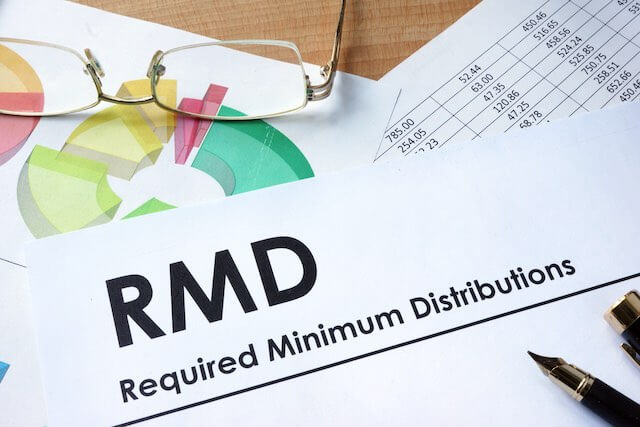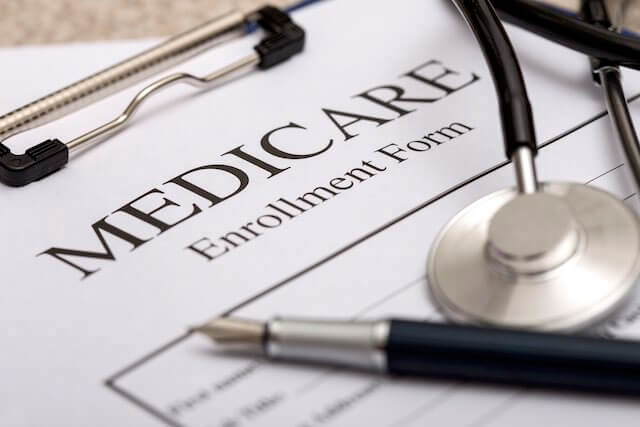As individuals navigate their retirement years, it becomes essential to understand the various factors that impact Medicare premiums, such as: earned income, self-employment income, investments, real estate, rental income, retirement withdrawals, Social Security, and pensions.
In this article, we will explore the relationship between Medicare premiums and how Required Minimum Distributions (RMDs) can affect retirement income planning and healthcare costs.
Required Minimum Distributions (RMDs)
The age for RMDs has recently changed due to SECURE Act 2.0. The current age to begin RMDs has increased to age 73 starting in 2023 (up from age 72). RMDs will increase to age 75 starting in 2033.
RMDs only require withdrawals from traditional funds whether that is a 401(k), TSP, IRA, or other traditional type retirement plan. Roth funds are NOT subject to RMDs.
How to Calculate the RMD
The required minimum distribution for any year is the account balance as of the end of the immediately preceding calendar year divided by a distribution period from the IRS’s “Uniform Lifetime Table.” There is a different table if the sole beneficiary is the owner’s spouse who is ten years or more younger than the owner.
The example below uses a $1,250,000 traditional TSP balance and the Uniform Lifetime Table for a single person.
| Age | Distribution Period | % of Account Value | RMD Due |
|---|---|---|---|
| 72 | 27.4 | 3.65% | $ 45,620.44 |
| 73 | 26.5 | 3.77% | $ 47,169.81 |
| 74 | 25.5 | 3.92% | $ 49,019.61 |
| 75 | 24.6 | 4.07% | $ 50,813.01 |
| 76 | 23.7 | 4.22% | $ 52,742.62 |
| 77 | 22.9 | 4.37% | $ 54,585.15 |
| 78 | 22.0 | 4.55% | $ 56,818.18 |
| 79 | 21.1 | 4.74% | $ 59,241.71 |
| 80 | 20.2 | 4.95% | $ 61,881.19 |
| 81 | 19.4 | 5.15% | $ 64,432.99 |
| 82 | 18.5 | 5.41% | $ 67,567.57 |
| 83 | 17.7 | 5.65% | $ 70,621.47 |
| 84 | 16.8 | 5.95% | $ 74,404.76 |
| 85 | 16.0 | 6.25% | $ 78,125.00 |
| 86 | 15.2 | 6.58% | $ 82,236.84 |
| 87 | 14.4 | 6.94% | $ 86,805.56 |
| 88 | 13.7 | 7.30% | $ 91,240.88 |
| 89 | 12.9 | 7.75% | $ 96,899.22 |
| 90 | 12.2 | 8.20% | $102,459.02 |
2024 Medicare Part B & D Premiums are Based on Income
| Beneficiaries who file individual tax returns with modified adjusted gross income: | Beneficiaries who file joint tax returns with modified adjusted gross income: | Part B Premium | Part D Surcharge |
| Less than or equal to $103,000 | Less than or equal to $206,000 | $174.70 | |
| Greater than $103,000 and less than or equal to $129,000 | Greater than $206,000 and less than or equal to $258,000 | $244.60 | $12.90 |
| Greater than $129,000 and less than or equal to $161,000 | Greater than $258,000 and less than or equal to $322,000 | $349.40 | $33.30 |
| Greater than $161,000 and less than or equal to $193,000 | Greater than $322,000 and less than or equal to $386,000 | $454.20 | $53.80 |
| Greater than $193,000 and less than $500,000 | Greater than $386,000 and less than $750,000 | $559.00 | $74.20 |
| Greater than or equal to $500,000 | Greater than or equal to $750,000 | $594.00 | $81.00 |
RMDs Pushing You Into Higher Medicare Part B & D Premiums
Before receiving RMDs, you may have been enjoying a nice retirement between Social Security, pension, and maybe a small withdrawal from the retirement account here and there. Left unchecked, the money in the traditional IRA is growing and compounding over the years.
Looming in the background are RMDs that can launch you into a higher tax bracket and increase the annual cost of health insurance. Proper knowledge of how RMDs work and a plan to lower a future RMD burden can help prevent this.
Let’s say you are a single, retired FERS annuitant and age 65. You are receiving a $5,000/month FERS pension, $2,780/month for Social Security, and not taking any withdrawals from a TSP account valued at $1,250,000.
| FERS Pension | $60,000 |
| Social Security | $33,360 |
| TSP Withdrawals | $0 |
| Total Income | $93,360 |
Your total income would place you in the lowest Medicare Part B premium at $174.70/month and $0/month for Part D.
If we use the same scenario but change the age to 73, the Medicare Part B premium jumps to $349.40/month for Medicare Part B and $33.30/month for Part D. That’s almost $2,500/year MORE for the same health coverage.
| FERS Pension | $60,000 |
| Social Security | $33,360 |
| TSP RMDs | $47,169 |
| Total Income | $140,529 |
This is a simple explanation of how RMDs can increase health insurance in the future. The most likely scenario may be even worse. A balanced investment strategy will generally outgrow inflation and withdrawals in the retirement account.
In the previous example of the 65-year-old retiree, let’s assume the TSP is growing at a rate of 6% with no withdrawals until age 73. The account value will have grown from $1,250,000 to $1,992,310 at age 73. The RMD is much larger now.
In this scenario, your Medicare Part B premium is now $454.20/month and Part D is $53.80/month which is an increase of $4,000/year.
| FERS Pension | $60,000 |
| Social Security | $33,360 |
| TSP RMDs | $75,181 |
| Total Income | $168,541 |
The TSP will continue to grow if you have the funds invested and are taking zero to moderate withdrawals. The compounding growth over the years will balloon the RMD down the road. Yes, Medicare income brackets will increase but are usually matched with inflation. The goal of an investment strategy is not just to keep up with inflation but to exceed inflation in the long term.
What Can You Do?
There are some strategies to reduce health insurance premiums and taxes down the road. Conducting Roth conversions is a great way to reduce RMDs in the future as Roth IRAs do not have RMDs. You can make small systematic withdrawals below higher tax brackets. If you are charitable, using a Qualified Charitable Distribution (QCD) will reduce income while giving to a charitable cause. There is also the Qualified Longevity Annuity Contract (QLAC) that can avoid taking RMDs until age 85.
Important!
Federal employees should take the time to understand their decision on whether to take Medicare Part B or not at age 65. If you will fall into a premium of $349.40 or higher you may not see the financial incentive of taking Part B. Effective planning today will enable you to grasp your current and future income, potentially saving you thousands of dollars in the long run.
The content is developed from sources believed to be providing accurate information. The information in this material is not intended as tax or legal advice. Please consult legal or tax professionals for specific information regarding your individual situation. The opinions expressed and material provided are for general information and should not be considered a solicitation for the purchase or sale of any security. Securities and advisory services offered through Osaic Wealth, Inc., member FINRA, SIPC. Osaic Wealth is separately owned and other entities and/or marketing names, products or services referenced here are independent of Osaic Wealth. Representatives may not be registered to provide securities and advisory services in all states. Branch address: 10701 Parkridge Blvd, Ste 130, Reston, VA 20191. Branch phone: 571-543-2783.





